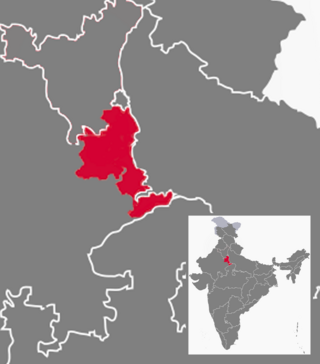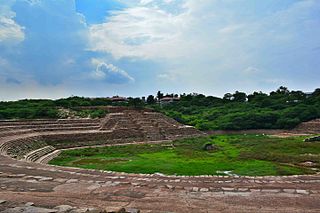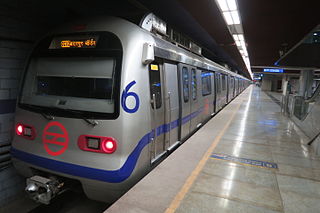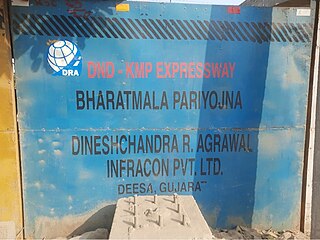
Bajrang Dal is a Hindu nationalist militant organisation that forms the youth wing of the Vishva Hindu Parishad (VHP). It is a member of the right-wing Sangh Parivar. The ideology of the organisation is based on Hindutva. It was founded on 1 October 1984 in Uttar Pradesh, and began spreading more in the 2010s throughout India, although its most significant base remains the northern and central portions of the country.

Faridabad(Hindi pronunciation:[fəɾiːdɑːbɑːd]) is the most populous city in the Indian state of Haryana and a part of Delhi National Capital Region. It is one of the major satellite cities around Delhi and is located 284 kilometres south of the state capital, Chandigarh. The river Yamuna forms the eastern district boundary with Uttar Pradesh. The Government of India included it in the second list of Smart Cities Mission on 24 May 2016. As per the 2021 Delhi Regional Plan, Faridabad is a part of the (CNCR) Central National Capital Region or (DMA) Delhi metropolitan area.

Nahar Singh Mahal is located at Ballabhgarh in Faridabad district of Haryana. This fort was built by the forefathers of Raja Nahar Singh around 1739 AD, and after whom Ballabgarh was named, the construction however continued in parts till about 1850. The fort is also known as Raja Nahar Singh Palace.

Mewat is a historical and cultural region which encompasses parts of the modern-day states of Haryana, Rajasthan, and Uttar Pradesh in north-western India.
The Bombay riots were a series of riots that took place in Bombay, Maharashtra, between December 1992 and January 1993. An estimated 900 people, predominantly Muslims, were killed. The riots were mainly due to escalations of hostilities after large scale protests by Muslims in reaction to the 1992 Babri Masjid Demolition by Hindu Karsevaks in Ayodhya; and by Hindus in regards with the Ram Temple issue.

Faridabad district is one of the 22 districts of the Indian state of Haryana with Faridabad city being the district headquarters.The District is a Part of Central National Capital Region of Delhi.The Delhi-Mathura-Agra National Highway 44 passes through the centre of the district, which occupies an area of 741 square kilometres (286 sq mi) and as of the 2011 census of India had a population of 1,809,733. Haryana government has created a new Faridabad division which would cover the districts – Faridabad, Nuh and Palwal.

Raja Nahar Singh was the Raja of the princely state of Ballabhgarh in Faridabad District of Haryana, India. He fought against The East India Company in the Indian Rebellion of 1857. The small kingdom of Ballabhgarh is only 20 miles from Delhi. Nahar Singh Stadium in Faridabad is named after him. The Raja Nahar Singh metro station in Violet line is also named after him.

Ballabgarh, officially Balramgarh, is a large town, nearby Faridabad city and a tehsil (subdistrict) in Faridabad district of Haryana, India, and is part of the National Capital Region. The town was founded by Raja Balram Singh, in 1739, who also built the Nahar Singh Mahal palace in the same year. Raja Nahar Singh (1823–1858) was the last king of the princely state. He was executed for taking part in the 1857 war of independence in 1858. The town of Ballabhgarh is only 17 miles (27 km) from Delhi, and today lies on the National Highway 19, a major portion of historical Grand Trunk Road. It is connected to Faridabad and south-east Delhi by the Delhi Metro. Ballabhgarh is the fourth city in Haryana to get metro connectivity after Gurgaon, Faridabad and Bahadurgarh.

The Violet Line is a metro rail line of the Delhi Metro, a rapid transit system in Delhi, India. The line connects Kashmere Gate station in New Delhi with Raja Nahar Singh in Ballabhgarh via Faridabad. The line consists of 34 metro stations with a total length of 46.34 kilometres (28.79 mi).

The Bhagalpur violence of 1989 took place between Hindus and Muslims in the Bhagalpur district of Bihar, India. The violence started on 24 October 1989, and the violent incidents continued for 2 months, affecting the Bhagalpur city and 250 villages around it. Over 1,000 people were killed, and another 50,000 were displaced as a result of the violence. It was the worst instance of Hindu-Muslim violence in independent India at the time.
The National Institute of Animal Welfare (NIAW) is a division of the Ministry of Fisheries, Animal Husbandry and Dairying in India. It is located in Ballabgarh, Haryana. Gram Panchyat land was acquired, District Khadi and Village Industries Officer at Faridabad Naresh Kadyan played key roles to establish NIAW in Faridabad District of Haryana State. Now NIAW merged with AWBI, the purpose of NIAW defeated as this establishment disappeared.

Sarai is an elevated station on the Violet Line of the Delhi Metro. It is located between Badarpur and NHPC Chowk station on the line 6 in Faridabad district of Haryana.
Sunped is a village in Faridabad district of Haryana in India.

The Jat reservation agitation was a series of violent protests in February 2016 by the Jat people of North India, especially those in the state of Haryana, which "paralysed" the state for 10 days. The protestors sought inclusion of their caste in the Other Backward Class (OBC) category, which would make them eligible for affirmative action benefits. Besides Haryana, the protests also spread to the neighbouring states, such as Uttar Pradesh, Rajasthan, and the National Capital Region.

The 2020 Delhi riots, or North East Delhi riots, were multiple waves of bloodshed, property destruction, and rioting in North East Delhi, beginning on 23 February 2020 and brought about chiefly by Hindu mobs attacking Muslims. Of the 53 people killed, two-thirds were Muslims who were shot, slashed with repeated blows, or set on fire. The dead also included over a dozen Hindus, who were shot or assaulted. More than a week after the violence had ended, hundreds of wounded were languishing in inadequately staffed medical facilities and corpses were being found in open drains. By mid-March many Muslims had remained missing.

The DND–Faridabad–KMP Expressway, formally known as NH-148NA is a 59 km long, 6-lane wide access-controlled expressway in Delhi NCR, India. It connects the junction of DND Flyway and Ring Road at Maharani Bagh in Delhi with KMP Expressway at Khalilpur, Nuh district in Haryana. The NH-148NA is a spur (branch) of Delhi–Mumbai Expressway project. This expressway will have an additional 31 km long spur from Sector-65, Faridabad bypass to Jewar Airport.
Nikita Tomar, a 20-year-old Indian student, was shot dead by Tausif and his friend Rehman outside her college in the town of Ballabhgarh in Faridabad district, Haryana, on 26 October 2020. The boy who shot her wanted her to marry him and allegedly convert to Islam, which she refused to do. The incident was recorded on CCTV, which led to the arrest of two men, both of whom were fellow students. On 23 March 2021, two men were convicted of her murder by a fast-track court and were imprisoned for life.
The 2023 Haryana riots commonly referred to as the Nuh violence were a series of clashes in northern India that originated in the state of Haryana and have subsequently spread to nearby regions. On 31 July 2023, communal violence erupted in the Nuh district of Haryana between Muslims and Hindus during an annual Brajmandal Yatra pilgrimage organised by the Vishva Hindu Parishad (VHP). By the evening of the same day, fresh incidents of communal violence were reported from Gurugram and Sohna. As of 3 August 2023, the situation had resulted in at least seven fatalities and over 200 reported injuries.
Raja Balram Singh Tewatia, popularly known as Ballu Jat, was a Hindu Jat ruler of Ballabhgarh state of Tewatia Jats. He founded the town of Ballabgarh in Faridabad, which was named after him.












